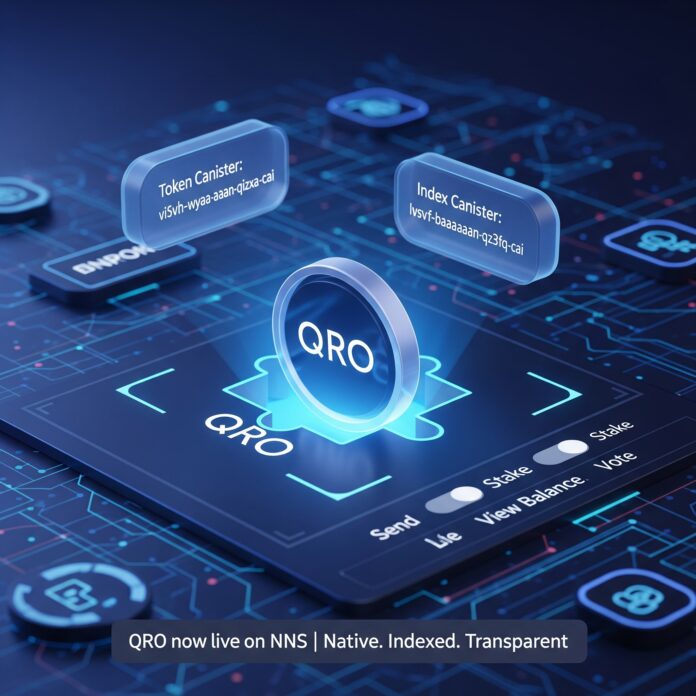QRO is now officially part of the Internet Computer’s Network Nervous System (NNS), and the token’s presence brings another functional asset to the decentralised infrastructure of the ICP ecosystem. The deployment of the required index canister signals that users can smoothly manage and interact with QRO on the NNS interface, streamlining participation and transparency for holders.
The launch is being described by developers as clean and efficient, thanks to the support of two core components: the QRO Token Canister (vi5vh-wyaaa-aaaan-qizxa-cai) and the QRO Index Canister (lvsvf-baaaa-aaaan-qz3fq-cai). Together, these canisters make QRO fully compatible with NNS-based actions, enabling visibility and ease of interaction within the growing Internet Computer framework.
The token canister handles the creation and distribution of QRO tokens, much like other token contracts on various chains. What sets this apart within the NNS is the seamless way the Internet Computer structure treats tokens more like first-class citizens, allowing deeper integration into apps and services being built directly on-chain.
The index canister, meanwhile, acts as a ledger-like observer, indexing all the necessary balances and transactions tied to QRO across the network. Without it, NNS interfaces would be blind to user activity. With it, they can provide real-time updates, transparency for users, and smooth UX for services using QRO in any form.
Developers and token users now have a more frictionless path to integrating QRO across other ICP services. NNS Dapp developers can pull index data directly, or interact with the token for services such as decentralised finance, DAO voting, or asset management tools native to the ICP world. It lowers the entry threshold for any ICP-based wallet, dapp or service wishing to onboard QRO.
The Internet Computer ecosystem has slowly but steadily been expanding its list of available tokens. While some rely on wrapped assets from bridges or external networks, QRO’s inclusion is natively deployed and reflects a community-forward approach. Projects opting for ICP-native deployment can benefit from ultra-low fees, high-speed updates, and on-chain governance pathways that make off-chain admin tools less necessary.
The inclusion of QRO on the NNS indicates a certain maturity. The token has moved beyond its early experimental stages and now wants to tap into the wider network of applications, tools and integrations that NNS offers. It’s no longer just about tokenomics. It’s about interoperability, clarity, and easier access for holders across the ecosystem.
With an assigned index canister now watching over user balances, even those building third-party dashboards or wallet extensions can more easily include QRO support. For users, this typically translates to clearer portfolio tracking and better functionality when using native Internet Computer wallets like Plug or Bitfinity.
There’s also a governance element at play. Tokens on the NNS have pathways to participate in governance and protocol activity. Although QRO hasn’t announced formal steps in this direction, its deployment lays down the infrastructure to support this. If a QRO-based DAO or community governance scheme emerges, this back-end is ready to go.
The plug-and-play design of ICP canisters means token additions like QRO can quickly start supporting functionality far beyond holding and sending. Developers can design staking mechanisms, service access controls, subscriptions, or even token-gated features using the token canister as the core logic anchor. The canister model is composable and highly secure, benefitting from the deterministic and tamper-resistant environment the IC provides.
QRO’s move may look like a small technical step but sits within a larger context of building token liquidity and community support directly on-chain. With the index canister activated, any smart contract or canister interacting with QRO will now benefit from consistent and synchronised data access. Whether that’s for showing user balances, querying past transactions, or building dynamic user rewards—QRO is now easier to work with.
From a user perspective, nothing complicated is required. Adding QRO to the NNS is now as simple as selecting the token, checking your balance, and moving assets within the ICP infrastructure. The clunky days of bridging tokens or jumping between external apps just to view a balance are slowly fading. This is the core strength of the IC model, and QRO’s move supports it.
The use of the NNS to manage assets like QRO shows how the Internet Computer is gradually becoming more application-aware. Tokens are no longer siloed or isolated components, but integrable pieces of a wider tech environment. If QRO sees wider use across apps and wallets, it’ll be thanks to this early step: bringing it into full view of the NNS and building on its indexing capabilities.
There are implications for liquidity too. While the press release doesn’t mention listings or exchanges directly, assets deployed to the NNS often see better support in decentralised liquidity tools native to the IC, like Sonic or ICLighthouse. With the index canister live, any decentralised exchange on ICP can quickly support QRO trading pairs with the right liquidity pools set up.
The low-latency and zero-gas experience of ICP makes it attractive for both developers and end users. A token like QRO can take advantage of these properties, especially if it’s planning broader ecosystem participation. Whether that includes staking, lending or community governance, the technical side is now enabled.
There’s also growing interest from traditional devs experimenting with Web3 for the first time. Deployments like this show them that managing an asset on-chain doesn’t have to involve ten complex tools and hours of setup. On the Internet Computer, you set your canisters, update your NNS visibility, and your token is ready to be interacted with by any compatible service.
The cryptographic underpinning of the IC platform also means identity and access management can be integrated directly with QRO in the future. That opens pathways for more targeted use-cases where ownership of QRO grants certain features, community access, or subscription rights—useful in both enterprise and creator-led environments.
QRO’s addition to the NNS also signals to the broader ICP community that the token is committed to native integration. Some projects still sit outside or rely on bridges, increasing the risk of fragmentation. By contrast, QRO’s approach aligns with a smoother, NNS-native journey for users and builders alike.
It will now be easier for new users exploring the ICP ecosystem to come across QRO while exploring dapps, wallets or services. The token’s visibility is no longer hidden or dependent on third-party services—it’s available where people are already managing their ICP and other canister-based assets.
Whether or not QRO becomes a top token on the IC in terms of usage or volume remains to be seen. What’s clear is that it’s now ready to be used as a fully-functioning building block within one of the most integrated Web3 networks around.
And for the technically curious, both canister IDs are now live and queryable. QRO Token Canister: vi5vh-wyaaa-aaaan-qizxa-cai. QRO Index Canister: lvsvf-baaaa-aaaan-qz3fq-cai.
With deployment done, the next steps are likely to come from the community—projects deciding to adopt QRO for functions, liquidity pools, or as a governance layer in new canister dapps. Either way, it’s now sitting in the spotlight, ready to be plugged into whatever comes next.
Dear Reader,
Ledger Life is an independent platform dedicated to covering the Internet Computer (ICP) ecosystem and beyond. We focus on real stories, builder updates, project launches, and the quiet innovations that often get missed.
We’re not backed by sponsors. We rely on readers like you.
If you find value in what we publish—whether it’s deep dives into dApps, explainers on decentralised tech, or just keeping track of what’s moving in Web3—please consider making a donation. It helps us cover costs, stay consistent, and remain truly independent.
Your support goes a long way.
🧠 ICP Principal: ins6i-d53ug-zxmgh-qvum3-r3pvl-ufcvu-bdyon-ovzdy-d26k3-lgq2v-3qe
🧾 ICP Address: f8deb966878f8b83204b251d5d799e0345ea72b8e62e8cf9da8d8830e1b3b05f
🪙 BTC Wallet: bc1pp5kuez9r2atdmrp4jmu6fxersny4uhnaxyrxau4dg7365je8sy2q9zff6p
Every contribution helps keep the lights on, the stories flowing, and the crypto clutter out.
Thank you for reading, sharing, and being part of this experiment in decentralised media.
—Team Ledger Life


